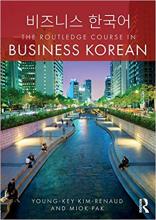The Routledge Course in Business Korean

The Routledge Course in Business Korean (비즈니스 한국어) by Young-Key Kim-Renaud and Miok Pak introduces the reader to the necessary vocabulary, grammar, and cultural knowledge to navigate the complex world of doing business in South Korea. The book is structured in 15 units and 3 business cases. Each unit starts with a dialogue about a specific business situation, such as a job interview or a business trip. The dialogue is then followed by a convenient vocabulary list that includes the new words introduced by the dialogue, along with their hanja reading and their English translation (note: romanization is not provided). New grammar patterns used in the dialogue are also discussed; the grammar points in this book are rather advanced and I think most suitable for upper intermediate to advanced learners of Korean. Units end with a reading passage, its associated vocabulary, and exercises to practice the vocabulary and grammar introduced in the unit. The three business cases included consist of longer reading passages with the corresponding vocabulary.
The Routledge Course in Business Korean is a great book for professionals who are working or want to work in Korea and wish to express themselves in Korean. The grammar and vocabulary introduced in this book are more suited to the upper intermediate to advanced learner of Korean.
The best things about the book The Routledge Course in Business Korean:
- The dialogues are more realistic than a lot of Korean books for foreigners (partly due to the more advanced content).
- Hanja (Chinese) characters are presented alongside new vocabulary, easing the reader into recognizing and learning new words based on the roots they already know.
- Romanization of the vocabulary is fortunately not provided, reducing clutter.
- Each grammar point is accompanied by several examples, making this book an appropriate companion to Korean grammar books, such as Korean: A Comprehensive Grammar.
The book has a few minor problems:
- The Routledge Course in Business Korean is not advertised as being for upper intermediate to advanced learners; beginners or lower intermediate readers would benefit little from this book.
- Some of the vocabulary (e.g., words related to factories) is hardly used in some business areas, but the reader is required to learn it in order to progress through the units. I do not see this as a major drawback, as this vocabulary is however good general knowledge to have.
- Some grammar explanations are confusing, but this is mitigated by the numerous examples provided.